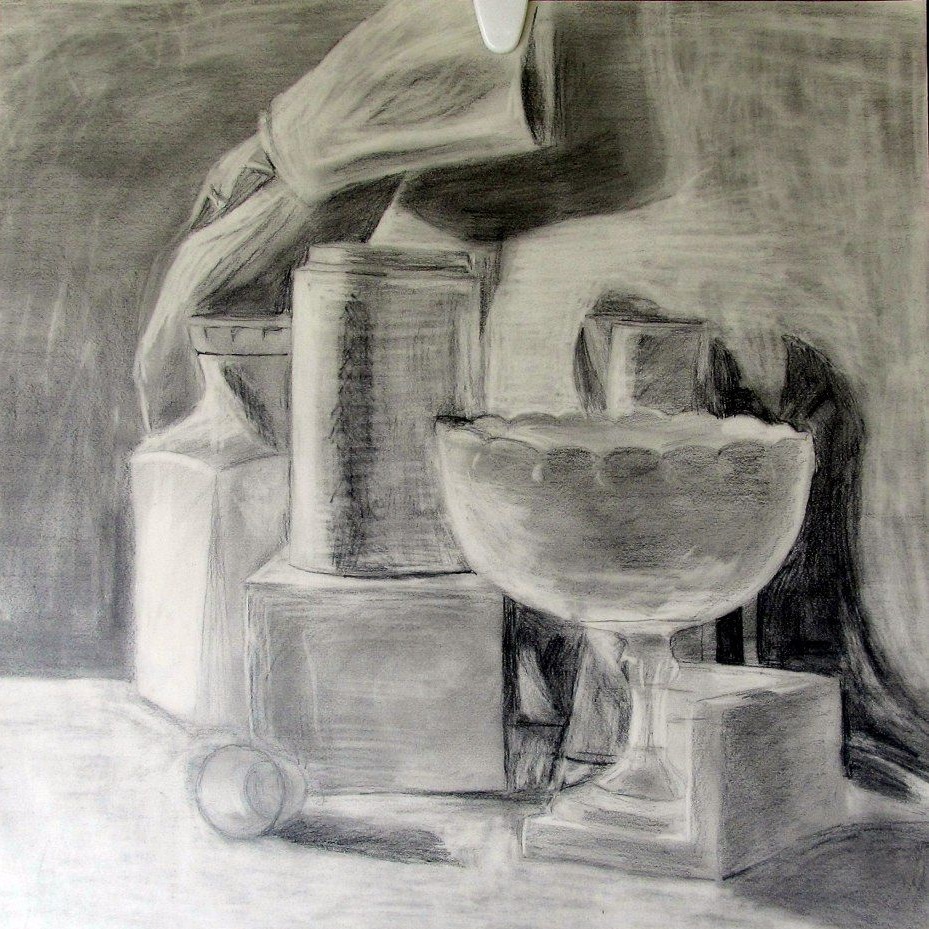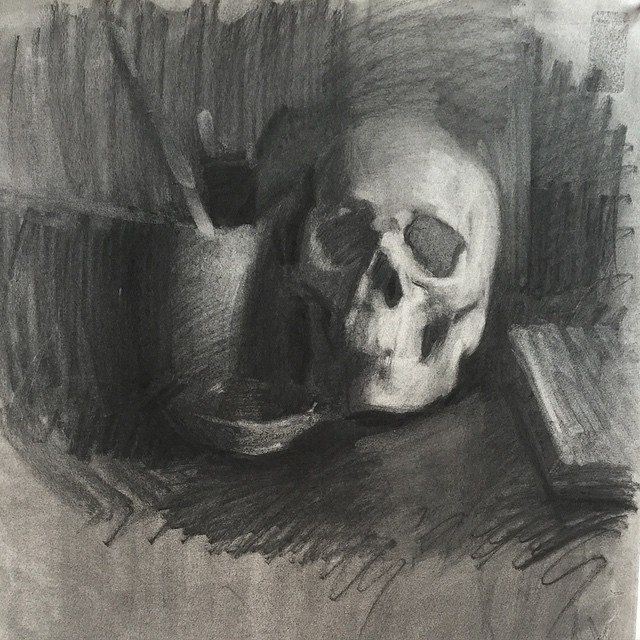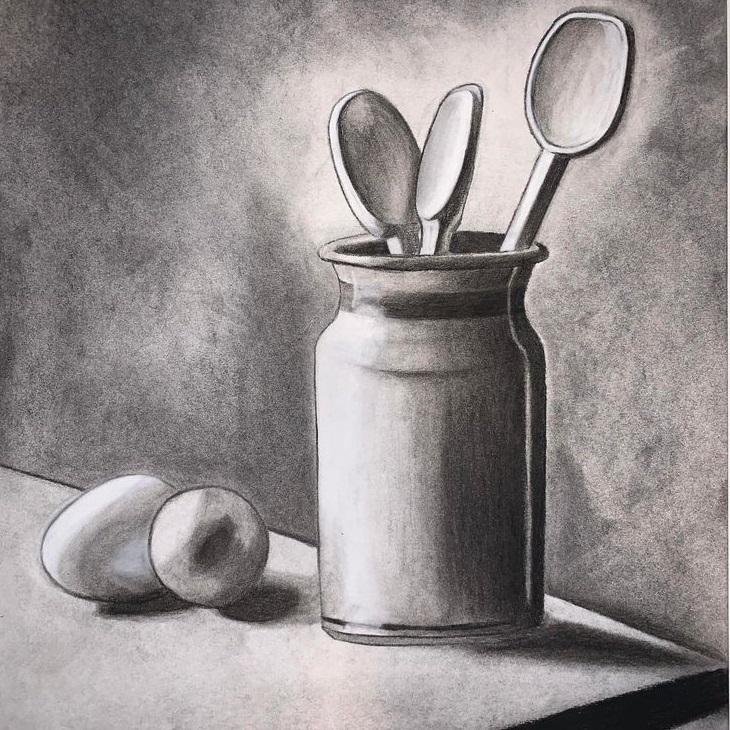The stark beauty of contrast in art can transform a simple still life into a dramatic visual experience. Charcoal is the medium of choice for artists who want to harness the power of contrast due to its rich blacks and versatile shading capabilities. Charcoal drawing encompasses a range of techniques that can be used to create striking still lifes with dramatic effects. This article delves into the methods and tips that artists can use to perfect the art of contrast in their still life charcoal drawing.
Understanding the Basics of Charcoal Drawing
Selecting the Right Materials
Before starting a charcoal drawing, it’s essential to select the right materials. Artists need a variety of charcoals such as vine, compressed, and pencil forms to create different textures and shades. High-quality, heavyweight paper that can withstand erasing and shading without tearing is also crucial. Materials such as kneaded erasers, blending stumps, and fixatives are tools that help manage the medium and preserve the artwork.
Mastering Charcoal Techniques
Familiarity with techniques such as hatching, cross-hatching, and stippling can enhance an artist’s ability to create contrast. It’s vital to understand how to control the pressure applied to the charcoal to achieve the desired level of darkness. Blending stumps and fingers can smudge the charcoal for soft shadows, while sharp edges can be defined with a kneaded eraser or charcoal pencil.

Composing the Still Life for Maximum Impact
Arrangement and Lighting
The composition of a still life can define the artwork’s impact. Artists should arrange objects with varying shapes, sizes, and textures to create an interesting and dynamic composition. Lighting plays a crucial role in contrast creation – by positioning the light source to one side, artists can cast dramatic shadows and highlights that accentuate the form of each object.
Emphasizing Focal Points
A still life should have a clear focal point that draws the viewer’s eye. Artists can enhance this effect by using the strongest contrasts of light and dark around this area. Placing the darkest shadows and brightest highlights near the focal point will make it stand out, adding depth to the drawing.
Executing High Contrast in Charcoal
Building Up Shadows and Highlights
Creating high contrast in still life charcoal drawing requires gradually building up shadows to achieve the deepest blacks while preserving the white of the paper for the brightest highlights. Artists should start lightly, increasing the density of charcoal for the shadows, and use an eraser to keep the highlights clean and bright.
Utilizing the Full Range of Tones
A rich tonal range is the key to dramatic contrast. Artists need to use not only the extremes of black and white but also the various grays in between. These mid-tones provide a transition between the darks and lights that can give the artwork a more three-dimensional feel.

Fine-Tuning Details for Realism
Adding Textures and Details
Details and textures bring a charcoal still life to life. Whether it’s the roughness of a fruit’s skin or the smoothness of a vase, these small touches make all the difference. Artists should observe their subjects closely and replicate these textures using precise strokes and careful blending.
Refining Edges and Contours
Edges and contours play a significant part in how realistic a drawing appears. Sharp, clean edges can suggest solidity and firmness, whereas softer edges can suggest distance or movement. Artists can use charcoals with different hardness ratings to refine these elements and bring clarity to their composition.
Overcoming Challenges with Charcoal
Controlling Dust and Smudging
Charcoal is notorious for its dust and potential to smudge. To keep their work clean, artists should frequently tap the paper to remove loose particles and keep a cloth handy to catch dust. Consider working from the top down to avoid smearing completed areas with the side of the hand.
Fixing Mistakes and Making Adjustments
Mistakes are inevitable, but in charcoal drawing, they are also manageable. Artists can use kneaded erasers to lift charcoal from the paper or add back highlights. Reapplying charcoal can darken areas that have become too light, and blending can smooth out any unevenness.

Protecting and Presenting the Finished Artwork
Fixing the Drawing
Once satisfied with the finished piece, artists must protect their work with a proper fixative spray. This helps in preventing smudging and fading. Remember to spray in a well-ventilated area and in multiple light coats to not disturb the layers of charcoal.
Choosing the Right Display
The presentation of a charcoal drawing can enhance its dramatic effect. Opt for a frame with UV-protective glass to prevent fading and choose a mat that complements the work’s tone. Where the artwork is displayed can also impact its visibility; placing it in an area with controlled lighting can show off the contrasts to great effect.
Planning Your Composition
The Importance of Sketching First
Preparation is key for a successful charcoal drawing. It’s important to begin with a light pencil sketch on your paper. This outline will guide the placement and proportion of objects in your still life charcoal drawing. It helps prevent major mistakes in size and perspective that could detract from the final piece.
Arranging Contrasts Thoughtfully
Plan where the darkest darks and the lightest lights will go before committing to charcoal. This approach enables you to consider carefully how the elements will interact and where the viewer’s eye will travel. Effective contrast is deliberate, not accidental, and a thoughtful arrangement can make your composition stand out.
Applying Basic Charcoal Techniques
Starting with the Big Shapes
Ignore the details in the early stages of your drawing. Focus on blocking in the big shapes first. Use sweeping, bold strokes to establish an overall sense of the composition. This broad application sets a foundation for building contrast and ensuring that each part of your still life relates to the whole.
Establishing Mid-tones
Mid-tones are essential in creating depth and form in your drawing. Lay them down early to develop a sense of light across the surface of your composition. Use the side of your charcoal stick for wider coverage and remember that these tones will change as you add darker areas and highlights.
Drawing Attention Through Contrast
Accentuating Key Elements
Once mid-tones are in place, you can accentuate key elements of your drawing with higher contrasts. Use your darkest charcoals to deepen shadows and define the outlines of your subjects where necessary. Keep your highlights reserved for areas that you really want to pop, using a kneaded eraser or a charcoal pencil to pull out lighter details.
Balancing Light and Dark
Maintain a balance between light and dark areas to prevent any part of your drawing from becoming too overwhelming. Adjust tones by layering and blending. This balance creates a harmonious relationship across the composition and enhances the overall drama of the piece.
Enhancing Depth and Volume
Shaping Forms with Shadows and Light
Use shadow and light to turn flat shapes into forms with volume. Observe how light naturally falls on each object in your setup and replicate these conditions on your drawing. Softly blend the edges of shadows to create the illusion of depth and roundness that makes objects look three-dimensional.
Varying Texture for Realism
Different objects have unique textures that can enhance the sense of realism in your drawing. Experiment with different marks to emulate these textures. Light cross-hatching can emulate a rough surface, while smoother shading achieves a glass-like appearance, adding to the depth of your still life.
Finishing and Refining Your Drawing
Reviewing and Revising
Stand back from your work frequently to review and revise. This broader view is important to see how all elements of your composition are working together. Make adjustments as needed to your contrasts and details, ensuring that nothing appears out of place or disproportionate.
Final Touches
In the final stage, add the smallest details which will bring your drawing to life—refined edges, subtle highlights, and defined shadows. These finishing touches should be done with the lightest hand to not overpower the rest of the piece. Remember, it’s often these final meticulous adjustments that make your drawing truly compelling.
Creating dramatic still life charcoal drawing requires an understanding of contrast, material mastery, compositional skills, and a flair for fine details. When brought together, these elements produce artwork that not only captures the eye but also stirs the emotions. It’s an art form that celebrates the dynamics of light and shadow, allowing the viewer to not just see but to feel the textures, shapes, and drama that a simple arrangement of inanimate objects can convey. Through practice, patience, and passion, any artist can master the art of contrast with charcoal and create still lifes that speak volumes.